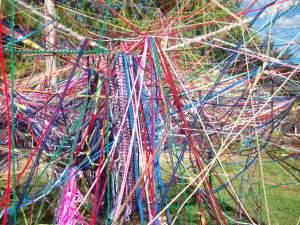
Camp Community Art Project: Diversity and Unity
You don’t have to be Jewish to love rye bread. And you don’t have to be Christian to love gospel, hymns, Sacred Harp singing, and other forms of traditional folk music rooted in European-American and African-American Christian cultures.
As a member of a Jewish and Christian interfaith family, I am aware that we have now entered the month of Elul in the Hebrew calendar, a time of reflection leading up to the High Holy Days. Looking ahead, we have Rosh Hashanah, Yom Kippur, the agricultural festival of Sukkoth, and Simchat Torah, all lined up like beads on the string of September. I planned my book launch this year for October, in order to give the Days of Awe proper space and respect, and so that I would be able to celebrate all these holidays.
So, I am thinking ahead to this “most Jewish season” in my interfaith calendar. But at the same time, in our family, August means spending a week in the mountains of West Virginia, immersed in Appalachian folk music with deep Christian roots. Many urban Americans became familiar with this music through the 2001 Coen brothers film, O Brother Where Art Thou? When we decided, after years of global travel in Africa and Latin America, to raise our children on the Mason-Dixon line, we thought that going deep into these local art forms would be one way of developing a sense of connection to our home. So when our children were just three and six, we began attending an annual family week through the Country Dance and Song Society. We spend the week contra dancing to old-timey string jams and Caribbean grooves and New England reels, singing British pub songs and Sacred Harp hymns, clogging, stomping, harmonizing, and creating art that symbolizes our sense of community.
Not everyone at camp is Christian—or white. Most years, we have enough Jewish families to gather for Shabbat blessings on Friday night. What binds us is love of music and dance, not religion or race. We are self-selected Jews who are confident enough to be comfortable when surrounded by hundreds of voices singing about angels, or the New Jerusalem, or Jesus himself.
Some of our camp favorites with church roots include “Count Your Blessings,” “Let the Work I’ve Done Speak for Me,” “There Are Angels Hovering Round,” “I Bid You Good Night” (recorded by both Aaron Neville and The Grateful Dead), “Down in the River to Pray,” and “How Can I Keep From Singing” (a Baptist hymn beloved by Quakers and recorded by both Pete Seeger and Eva Cassidy).
Perhaps it helps that many of us non-Christians grew up singing Christmas in our public schools. To the extent that we live in a Christian culture, we have all developed ways of living with this reality, or in my case, even embracing it. For me, raising my children in an intentional interfaith families community, with education in both religions, has helped me to be able to sing church music. When I sing about laying my head “upon my savior’s breast” I don’t think of Jesus as my own personal savior, but I do sing with an appreciation of the idea of Jesus as a comfort to many throughout American history.
Perhaps it helps that I have come to understand that some of those singing around me–progressive Christians of Quaker or Unitarian-Universalist or mainline Protestant affiliation–do not necessarily believe in Jesus as a literal messiah either, or as the son of a traditional God. Even agnostics and atheists, or cultural Christians, can and do claim and sing these songs, regardless of personal theology. Some of them substitute the word “love” for “God,” transforming lyrics such as, “See what God has done,” into “See what love has done.”
From birth, I sang my children lullabies in Hebrew, but also, Dona Nobis Pacem. Connecting my children to the soul-stirring songs of the European-American and African-American Christian music traditions, and encouraging them to lose themselves in the transcendence, and yes, spirituality, of singing and dancing to these musical forms, is part of giving them a positive connection to their own (interfaith) Christian heritage and to their American roots in Christian culture. And so, in this spirit, let the songs I sing speak for me.

